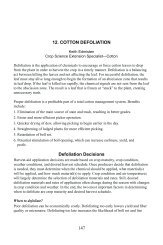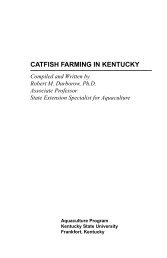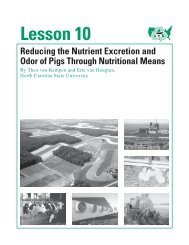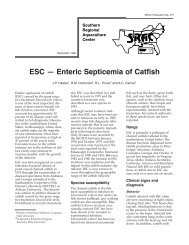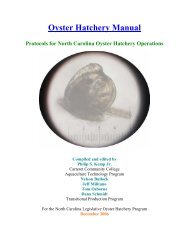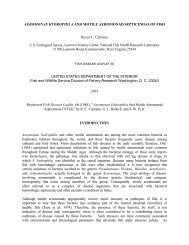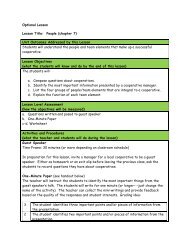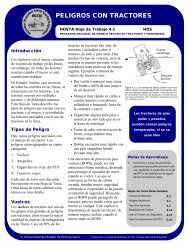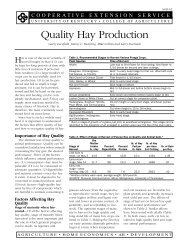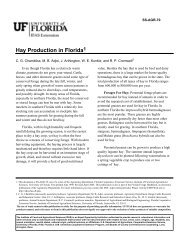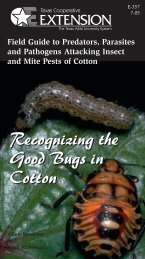Farming freshwater prawns A manual for the culture of ... - eXtension
Farming freshwater prawns A manual for the culture of ... - eXtension
Farming freshwater prawns A manual for the culture of ... - eXtension
Create successful ePaper yourself
Turn your PDF publications into a flip-book with our unique Google optimized e-Paper software.
Flow-through requirements <strong>for</strong><br />
ten 5 m 3 larval rearing tanks<br />
BOX 2<br />
I<br />
N A FLOW-THROUGH system,<br />
<strong>the</strong> salinity <strong>of</strong> <strong>the</strong> seawater or<br />
brine available controls <strong>the</strong><br />
amount <strong>of</strong> <strong>freshwater</strong> necessary to<br />
produce <strong>the</strong> 12 ppt brackishwater<br />
needed <strong>for</strong> larval rearing (Table 4).<br />
The daily consumption <strong>of</strong> 12 ppt<br />
water <strong>for</strong> a single 5 m 3 rearing tank in<br />
a flow-through system exchanging<br />
approximately 50% <strong>of</strong> <strong>the</strong> water per<br />
day would be 2.5 m 3 (2 500 L).<br />
However, emergencies sometimes<br />
occur, when it is necessary to rapidly<br />
change all <strong>the</strong> water in a tank.<br />
Pumping capacity must be sufficient<br />
to fill any tank with brackishwater<br />
within one hour in order to make <strong>the</strong><br />
daily water exchange as rapid as possible.<br />
Thus, in this example, <strong>the</strong><br />
pumping and pipe work capacity<br />
must be sufficient to supply a peak<br />
demand <strong>of</strong> 5 m 3 within an hour<br />
(approximately 83 L/min) to each<br />
tank. For a complete larval cycle,<br />
allowing <strong>for</strong> some additional<br />
exchange to solve rearing water quality<br />
problems and assuming that <strong>the</strong><br />
cycle lasts 35 days, a total <strong>of</strong> around<br />
90 m 3 <strong>of</strong> 12 ppt water would be consumed<br />
<strong>for</strong> every 50 000 PL produced.<br />
This is equivalent to about<br />
2.6 m 3 /day <strong>for</strong> each larval tank, or<br />
25.7 m 3 <strong>for</strong> ten tanks. Rounding up,<br />
and allowing an additional safety<br />
margin, a hatchery with ten tanks <strong>of</strong><br />
this size would need about 30 m 3 <strong>of</strong><br />
brackishwater per day.<br />
Assuming a steady intake salinity<br />
<strong>of</strong> 30 ppt (and referring to Table<br />
4), <strong>the</strong> requirement would be 30 ÷<br />
10 x 4 = 12 m 3 <strong>of</strong> seawater per day.<br />
The need <strong>for</strong> <strong>the</strong> larval tanks would<br />
be 30 ÷ 10 x 6 = 18 m 3 <strong>of</strong> <strong>freshwater</strong><br />
per day.<br />
In addition, sufficient <strong>freshwater</strong><br />
to maintain holding tanks <strong>for</strong> PL must<br />
be provided. For a hatchery operating<br />
ten 5 m 3 larval tanks, facilities <strong>for</strong><br />
providing an average <strong>of</strong> 20 m 3 /day<br />
<strong>of</strong> additional <strong>freshwater</strong> (based on a<br />
PL stocking density <strong>of</strong> 5 000 PL/m 2<br />
and an average water exchange rate<br />
<strong>of</strong> 20%/day: 500 000 ÷ 5 000 x 20 ÷<br />
100) will be needed during <strong>the</strong> periods<br />
when postlarval holding tanks<br />
are being operated. [Note: much<br />
larger quantities <strong>of</strong> <strong>freshwater</strong> will<br />
be needed if <strong>the</strong> PL are held <strong>for</strong><br />
more than one week, because stocking<br />
densities will have to be<br />
reduced]<br />
The total water consumption <strong>for</strong><br />
a hatchery operating ten 5 m 3 tanks<br />
producing 500 000 PL in each larval<br />
cycle and selling <strong>the</strong> PL within one<br />
week after metamorphosis would<br />
<strong>the</strong>re<strong>for</strong>e be 12 m 3 <strong>of</strong> seawater and<br />
18 + 20 = 38 m 3 <strong>of</strong> <strong>freshwater</strong> per<br />
day.<br />
market is <strong>the</strong> first topic that you should consider and <strong>the</strong> results <strong>of</strong> your evaluation will<br />
determine whe<strong>the</strong>r <strong>the</strong> site is satisfactory and, if so, <strong>the</strong> way in which <strong>the</strong> farm should be<br />
designed and operated. Despite <strong>the</strong> obvious importance <strong>of</strong> <strong>the</strong> market, it is surprising how<br />
<strong>of</strong>ten that this topic is <strong>the</strong> last criterion to be investigated. It is considered in more detail<br />
later in this <strong>manual</strong>.<br />
It also important to consider o<strong>the</strong>r factors to ensure success, including <strong>the</strong>:<br />
<br />
<br />
<br />
<br />
<br />
<br />
<br />
<br />
suitability <strong>of</strong> <strong>the</strong> climatic conditions;<br />
suitability <strong>of</strong> <strong>the</strong> topography;<br />
availability <strong>of</strong> adequate supplies <strong>of</strong> good quality water;<br />
availability <strong>of</strong> suitable soil <strong>for</strong> pond construction;<br />
maximum protection from agricultural and industrial pollution;<br />
availability <strong>of</strong> adequate physical access to <strong>the</strong> site <strong>for</strong> <strong>the</strong> provision <strong>of</strong> supplies and<br />
<strong>the</strong> movement <strong>of</strong> harvested animals;<br />
availability <strong>of</strong> supplies <strong>of</strong> o<strong>the</strong>r necessary inputs, including postlarval and/or juvenile<br />
<strong>prawns</strong>, equipment, aquafeeds or feed ingredients, and power supplies;<br />
availability <strong>of</strong> good skilled (managerial) and unskilled labour;<br />
CHAPTER 2<br />
17




